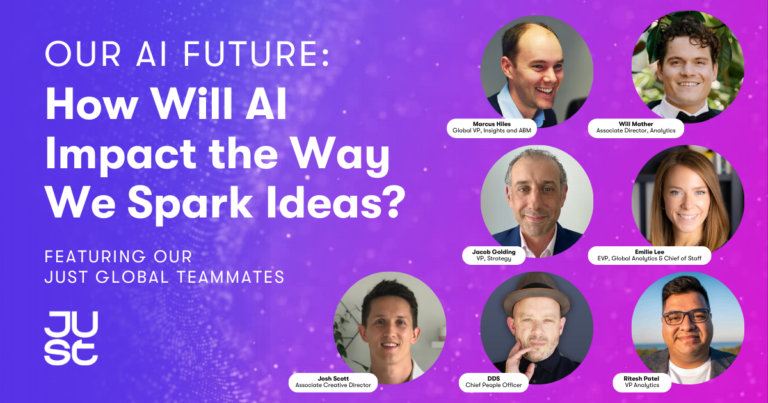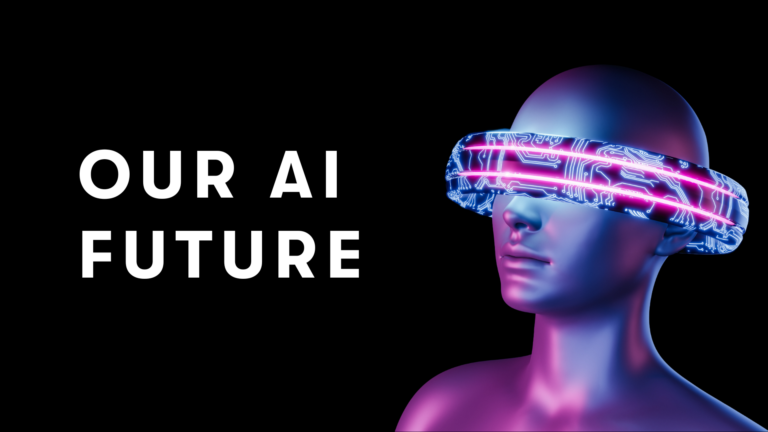AI is saving time and costs in the creative process. But where is this AI revolution heading?
In the fourth part of our series, Just Global EVP of Creative and Content, John Langstone explains what the creative landscape may look like in the non-too-distant future.
One of the great things about AI is its flexibility and adaptability. There are different forms of AI and the way it’s being used. We’ve been using AI as part of the creative process for a while, and the question on everyone’s lips is whether AI will eventually replace designers, copywriters, and creative design. My answer is ‘no’. That would rely on us receiving a perfect brief – and that rarely happens – given an integral part of the creative process is the way all the invested stakeholders collaborate to ensure the final brief ticks all the boxes.
AI offers greater utility to designers
When you think about it, AI has long been an asset to designers. Consider the myriad of Photoshop tools that automatically enhance images and complete missing elements, as well as the algorithms that streamline component weight and adaptive typography. The evolution of AI won’t necessarily mirror humans. Instead, its manifestation in abstract forms, such as the Cloud, would appear to offer greater utility to designers.
As creatives, we still need to come up with the core idea ourselves"
One solution is Adobe’s Firefly which sits on the backend of Photoshop. It allows us to hook into ideas and then expand on those ideas. But as creatives, we still need to come up with the core idea ourselves. Campaign concepts are often hugely ambitious, and hard to achieve – whether that’s down to budgets or timelines. What Firefly allows us to do is create derivatives of our ideas as well as expand on an illustrative or conceptual idea. On one hand, there’s predictive AI, which predicts what you’re trying to do, but there’s instructive AI – which is how Firefly works, giving you much more control.
Better synergy
As a designer who engages with creative technologies in my workflow, where a human-centric approach holds significance, I find myself advocating for both human expertise and technological capabilities. Indeed, with the advancements in human-machine collaboration, our synergy is enhanced. The perpetual debate of humans versus machines has always eluded me. Contemporary machines resemble companions, aiding us functionally and even emotionally.
Virtually all the challenges we encounter as creatives necessitate a deeply empathetic human perspective to comprehend and resolve human-centric issues. These challenges inherently encompass both functional and emotional dimensions. Currently, I remain skeptical about AI’s capacity to surpass our emotional design intelligence. However, AI undeniably assumes a pivotal role in supporting us within the functional realms of design.
Enhancing the value of designers
Much like how programs such as Photoshop rendered once-prized skills like typesetting obsolete upon their introduction, the field had to adapt and evolve. A parallel transformation awaits with AI. Designers must take the initiative to enhance their proficiency in these emerging technologies and incorporate them into their repertoire, available for utilization as needed.
From my standpoint, this enhances the value of creatives, as they become responsible for ensuring the novelty of products and experiences that resonate with people and align with ecological considerations, thereby upholding standards of creative excellence.
Saving time and money
When AI is employed to conceptualize novel products or services for individuals, it becomes imperative to be mindful of the data it relies upon and the ethical ramifications of any ingrained biases. Consequently, pre-emptive consideration of potential unintended outcomes is crucial before embarking on the design of new experiences.
To some, this brave new world of AI is seen as heralding the end of the creative department as we know it. But that’s forgetting the fact that original ideas are only something we can spark.
Unanswered questions around AI remain – such as copyright issues, and who owns an image if it’s created by AI – and regulation is already being drafted in the European Parliament to ensure full disclosure if content is generated by AI. Legislation is being introduced on an ongoing basis, so it’s advisable to check what the law is where you are. One thing’s for certain – AI will continue to become more sophisticated, and that can only be a good thing for the creative process.
To find out how our award-winning creative team can help you develop successful campaigns, get in touch.
With nearly three decades of experience, John is responsible for the creative direction and delivery of concept development, brand identity, video and animation, editorial and copy, and ABM persona development at Just Global.

Just Global teammates share how they sparked ideas, and what difference they see AI making to the way they do this.

In the second piece in our series, we take a deeper dive into the world of Generative AI with a one-to-one interview with Marcus Hiles, our Global VP of Insights and ABM.

In this first piece, Just Global’s VP of Insights and ABM, Marcus Hiles, explores the growth of Generative AI and its impact on an organization.

